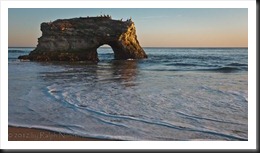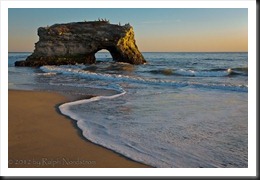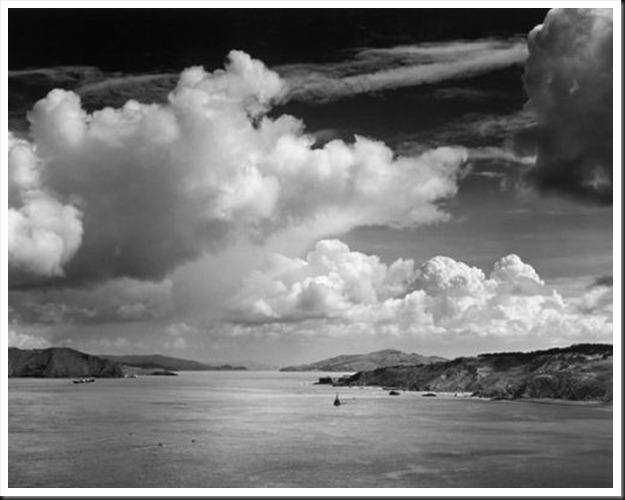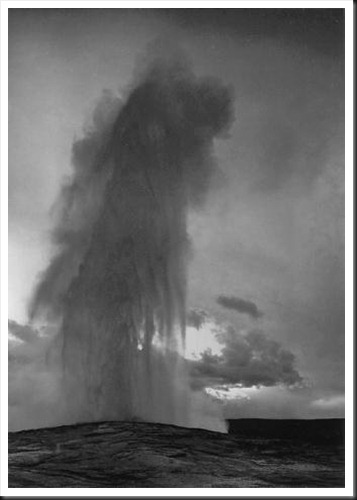I was fortunate to be in Big Sur last week photographing that magnificent coast with the members of our workshop. Ansel Adams made some beautiful photographs here as did, of course, Edward Weston. An increasingly common technique used by photographers is to employ a neutral density filter to get very long exposures that turn the ocean into a sea of ethereal mist. Many of these photographs are incredibly beautiful. Personally, I connect with the power and energy of the ocean, something these beautiful photographs do not capture.
Adams’ technique was to stop the motion in of the surf as in this photograph titled “Rock and Surf.” Freezing the water was essential to the effectiveness of the composition.
Rock and Surf (1951)
Ansel Adams
This photograph captures a peaceful, graceful moment along the Big Sur coast. The composition is exquisite with all of the elements in the lower part of the image drawing the viewer’s eye and attention to the rock outcrop just offshore. The surf is a key element in the composition. What looks so natural and effortless is actually very difficult as Adams explains in the narration that accompanies this photograph.
“Surf is seldom predictable in its ebb and flow. It constantly presents fresh shapes, and the eye must be swift and anticipation keen to expose at the most favorable moment for the particular composition consistent with the visualization… Many waves broke on the sand and curled around the rocks before the one I photographed. The impulse to operate the shutter came at the appropriate fraction of a second before the foam curves met as we see them in the image. Anticipation is a very important part of the photographer’s training, and is acquired only by much practice.”
This is something I’ve become very aware of, the way the surf is a critical element of the composition. At a given location the surf initially appears to be random and chaotic. But with patient observation, patterns begin to emerge. And some patterns definitely contribute more strongly to the composition than others. Often these patterns are in the minority. Take for example a couple of photographs I made of of Natural Bridge in Santa Cruz, California.
The leftmost image has some interesting curves in the surf but the rightmost image has the more effective composition where the S-curve in the surf draws the viewer’s eye to the rock.
Some photographers I’ve studied with have suggested that it is not necessary for landscape photographers to get intimately familiar with their subjects, that great art can be created without knowing the name of a tree or the geology of a mountain. And I suppose there is truth in that position. But I prefer to try to communicate the essence of a subject in my photographs and to do so I find that educating myself on the natural history of an area contributes to an understanding that hopefully translates to my photographs. And besides, it’s fascinating and deepens my appreciation of what I’m seeing and experiencing.
Surf is a prime example. The more I photograph surf the more I understand its behavior and can anticipate how it will contribute to a strong composition. There are a few things I’ve learned about surf and photographing it that I’d like to share with you. Perhaps the most important is to be patient and just observe. We have a tendency to set up our cameras and start firing away. Film photographers, especially large format photographers, didn’t have the luxury we enjoy. They took a limited number of sheets of film with them every time they went out. And there was a cost every time they pressed the shutter. So they were forced to slow down and connect with the scene, especially scenes as dynamic as those involving moving water. Compared to that, we have virtually an unlimited amount of ‘film’ and can take hundreds of shots with a good chance of one of them capturing the critical moment. But I’ve come to understand that surf is not totally random and chaotic.
Perhaps the first thing to understand about surf (and this is something surfers understand exceedingly well) is that the big waves comes in sets. So if you missed a big one, stick around because another big set will come in a few minutes. And the thing about big sets is there are generally three to five large waves and the largest one is often the second or third. This is not a hard and fast rule but it works most of the time. This can help you anticipate when the biggest one will hit.
But there are other more subtle factors that affect surf. The play between the ocean and the shore is affected by the tide. The level of the tide, high, low, in between, coming in or going out can completely change a scene. So the wave action you initially saw may be very different an hour later. Wind can affect the surf. The direction and intensity of the wind will affect the direction and the size of the waves. And if the wind blows for more than a day the affect will be amplified. Finally, offshore storms can generate huge seas while a calm in the weather will produce the opposite. All of these factors contribute to the fascination of photographing surf.
Water in its various forms is a most rewarding and challenging element to photograph. So I thought I’d conclude this post with a couple of Adams’ photographs that involved water in some of its other manifestations and that also required anticipation and precise timing.
The Golden Gate before the Bridge (1932)
Ansel Adams
Old Faithful Geyser (~1947)
Ansel Adams
Join the conversation. Leave a comment and share your thoughts and experiences on photographing water in its various forms. Also, please feel free to share this post and Like it.
Join me on an upcoming workshop. Click here for more details.
To see more of my photographs click here.
WordPress Tags: Ansel,Adams,Rock,Surf,workshop,Edward,Weston,technique,mist,Many,energy,composition,moment,image,viewer,attention,outcrop,element,narration,anticipation,expose,visualization,impulse,fraction,location,observation,Often,Take,example,Natural,Bridge,Santa,Cruz,California,Some,tree,mountain,truth,essence,subject,history,area,behavior,tendency,Film,luxury,cost,tide,action,Wind,direction,size,fascination,Water,Golden,Gate,Faithful,Geyser,Join,conversation,Leave,Also,Click,members,exposures,subjects,sheets,factors,manifestations,photographers
(3838)





